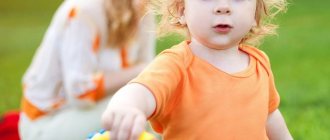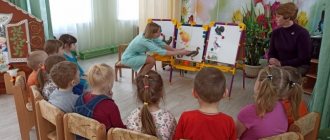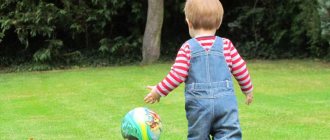Early childhood and speech development
Early age (from birth to 3 years) is a special period in a child’s life. In terms of the intensity of development and the complexity of the tasks solved at this stage, the first years of life have no equal. This is also the most favorable period for mastering the basics of your native speech. What gets missed now may require double effort later!
Would it surprise you if we told you that a child's speech abilities begin to develop even before he is born? And this is exactly so. Let's find out what actually affects the development of speech in a baby.
What factors influence speech development
- Biological: heredity; correct structure and functioning of the central nervous system, speech centers in the brain, hearing and speech organs; healthy pregnancy and successful birth; healthy physical and mental development after birth.
- Social: a full-fledged speech environment from the first days of a child’s life, a favorable developmental environment.
Speech development tasks
At all stages of growing up, a child masters different levels of oral interaction: the babble of a baby a few months old, the first words and sentences of older children.
Speech expands the possibilities for knowledge. In addition to manipulating objects around him, the child begins to fantasize and learn new things from the stories of others or fiction.
What tasks are performed during speech development:
- master your native speech as a tool for communication and learning;
- enrich your vocabulary (know and use many words);
- learn to speak clearly and correctly, to conduct a dialogue;
- learn the culture of communication (listen to your opponent, do not interrupt, consistently express your thoughts);
- get acquainted with the basics of speech creativity (retelling, composing stories, plots about your impressions of the phenomenon seen);
- listen and understand fairy tales and stories from children's literature;
- remember the correct language structures for future literacy learning.
How a child’s speech is formed from birth to 3 years
The baby learns to communicate with the outside world from the very moment of birth. Let's take a look at how the speech development of young children proceeds during the first 3 years of a child's life. Norms of speech development in children from 0 to 3 years
- 0 – 2 months. Scream. The first form of communication for a child is crying. The baby cries when he is hungry, uncomfortable or tired.
- 2 – 3 months. Booming. Crying is replaced by cheering. The sounds “a”, “s”, “u” appear, sometimes in combination with “g”. The child learns to understand speech addressed to him and control his own sound intonations.
- 3 – 6 months. Babble. The baby begins to babble to himself and make sounds when addressed to him. Turns his head towards the sound. Freezes in response to a sudden loud sound. Cries differently depending on needs: “I’m hungry,” “I’m tired.” Recognizes his name and reacts to it.
- 6 months. First syllables. From the age of 6 months, you can notice that the child prefers strictly certain sounds to all others: “ba”, “ma” (they are the easiest to learn to pronounce). He can repeat them endlessly: he likes the way they sound.
- 7 – 9 months. Combinations of syllables. The babbling progresses to the utterance of identical syllables: “ma-ma-ma”, “dya-dya-dya”, “ba-ba-ba”.
- 9 – 11 months. Onomatopoeia. The baby imitates the sounds of adults' speech. Responds to name. Understands the meaning of the word “no.”
- 11 – 13 months. The first meaningful words from two identical syllables: “dad”, “mom”, “baba”, “uncle”. 12 months. The baby shows interest and attention to the speech of others, repeats and combines sounds in a new way, combines them into “words”, imitating the speech of an adult. Understands and follows simple one-word instructions (“sit down”). He waves his hand “bye-bye”, shakes his head “no”. Uses gestures and sounds to attract attention. Interested in books.
Rarely does a parent know what signs indicate deviations in the child’s development. Therefore, for prevention, be sure to visit a pediatric neurologist at 3, 6, 9 and 12 months.
- 18 months. The baby easily repeats frequently heard words. Knows different parts of the body and points to them. Masters simple words (by the age of 2 years, their vocabulary can range from 20 to 50). Answers in words or gestures the questions: “Where is the bear?”, “What is this?” He loves when people read to him. At the request of an adult, he points his finger at the pictures in the book. 2 years. First sentences (two words). A two-year-old child can easily combine simple words mastered by the age of 2 into combinations: “Mom, give me,” “I want this,” “Where is the kitty?” Understands simple instructions consisting of two sequential actions: “Find your teddy bear and show it to grandma.” The vocabulary can expand to 150 - 200 lexemes, and others can already understand half of the words the child pronounces. The baby begins to use pronouns, adjectives and prepositions. Holds a book correctly in his hands. “Reads” to his toys.
- 3 years. Multi-word sentences (three or more words). At 3 years old, the period of early childhood ends. By this turning point, the child is able to compose sentences of three or more words. Distinguishes between colors and size definitions. Remembers and repeats familiar rhythms, melodies, stories. Some difficulties in sound pronunciation may still persist (whistling, hissing, vowel sounds). The vocabulary is expanding so much that parents can no longer accurately count how many words it consists of. In general, the baby is already ready to speak out on any occasion.
Psychological characteristics and stages of speech formation in preschool children
In the first years of life, the child develops mentally and physically, learns to control his body, think, and masters his native language. The formation of speech occurs sequentially; different age intervals have their own norms.
The ability to speak is an acquired skill that is developed in all children according to a similar scenario. In order to promptly notice deviations in speech development, it is necessary to know the patterns of mental maturation at an early age.
How a child’s speech is formed from birth to 3 years
In the first year after birth, all systems of the newborn actively develop: the structure of the brain matures and becomes more complex, phonemic hearing is formed, and the speech apparatus is trained during crying or involuntary sounds.
Stages of child speech development.
What is the initial stage based on:
- listening to everyday sounds, spoken speech and one’s own voice;
- imitation of an adult (repetition of heard sounds, syllables, and, at the age of about 12 months, words);
- the basics of understanding the meaning of what was said (mainly through emotions, intonation and facial expressions);
- the state of the articulatory apparatus (determines coherence in pronunciation, mobility of speech organs).
In the second year of life, there is a leap in the development of active speech.
The following is typical for communication at this age:
- attempts to use words meaningfully (to name an object);
- up to 1.5-1.8 years there are no common sentences, they are replaced by 1 word (“Drink” as a request);
- at 1.8-2 years the composition of phrases expands, but there is still no grammatical connection between words;
- vocabulary increases (100-300 words depending on the conditions, frequency and quality of communication with adults);
- the development of articulatory organs continues, but the voice has not yet become stronger;
- intonation is mastered;
- individual sounds are pronounced incorrectly (vowels are softened, consonants are skipped, syllables are confused), words are simplified (“Beep” instead of “Machine”).
Development of child speech from 3 to 4 years old
In the third year of life, the cognitive function of speech increases. The child becomes interested in the world around him, begins to ask simple questions, and engages in dialogue with peers.
The speech development of a three-year-old child includes the following stages:
- vocabulary is enriched (2-3 times compared to two years of age);
- verbs are used more often (up to 30% of the active vocabulary), prepositions and pronouns;
- there are errors in agreeing the gender of adjectives for naming objects;
- complex non-conjunctive sentences appear in speech (by the end of 3 years - complex sentences);
- listening comprehension of children's literature improves;
- the speech apparatus becomes mobile, but speech coherence and voice volume remain weak;
- when pronounced, long words with a complex structure are often shortened, syllables are swapped or dropped out;
- memory improves, creative thinking and imagination begin to develop;
- attention remains unstable, the child is distracted.
Interest in surrounding objects stimulates the preschooler to communicate with adults and be the first to start a conversation. In dialogue, the child learns to reason and begins to determine the simple relationship between phenomena.
What features of speech development distinguish the 4-year stage:
- the ability to select names for any objects or actions increases, including those that do not constantly surround the child;
- the arsenal of words is expanding (adjectives, numerals, adverbs, pronouns are actively used);
- retelling events or someone else's speech, talking about one's impressions remain inaccurate due to the inability to correctly choose the right words;
- illogicality and inconsistency of presentation remain, but the grammatical structure of speech improves;
- communication remains situational, requires clarification, the story is tied to the situation;
- memorization of poems, riddles, fairy tales improves, the child easily repeats them, but mostly does not understand the meaning;
- the speech apparatus is improved at an individual pace (by the end of 4 years, children can already speak clearly, intelligibly, or continue to simplify sounds).
Development of speech in a 3-4 year old child.
Formation of speech skills in children from 4 to 5 years old
At the age of five, a preschooler becomes receptive to the social environment. There is an interest in the development of speech hearing through word creation, attempts to rhyme or singing. The formation of speech occurs intensively, the child imitates the manner of communication in the family or kindergarten.
What stages of speech development do 5-year-old children go through:
- the colorfulness and variety of speech increases (in addition to the names of objects, the child knows their signs and is able to logically connect several objects with each other, relying on properties);
- attention does not dissipate, becomes stable;
- the vocabulary is replenished to 2.5-3 thousand words, which stimulates the development of monologue skills, but increases the number of errors and inconsistent phrases in speech;
- the speech organs are sufficiently trained for correct pronunciation, the coherence and clarity of sounds improves, speech becomes understandable to strangers and other children;
- in 30% of cases there are difficulties in pronouncing the sounds r, l, hissing;
- phonetic hearing develops, the ability to distinguish the subtleties of pronunciation (voice pitch, timbre, intonation, tempo).
Features of speech development of a preschooler aged 5-7 years
Children of senior preschool age master coherent speech and compose a monologue from complex sentences and extended phrases. People around you understand the child without further questions.
Signs of the formation of contextual speech in children 6 years old:
- abstract logical thinking develops, understanding of connections and relationships between phenomena, objects, people improves;
- the vocabulary is replenished with forms of already familiar words (prefixes or suffixes are added), 4-6 thousand words are actively used;
- the child operates with generalizing words, collects words into groups based on a common property, and is able to select pairs of antonyms;
- the number of grammatical errors decreases;
- the development of the basic functions of the articulatory organs and mobile muscles of the face is completed, which is why sounds are pronounced clearly;
- With regular implementation of developmental oral exercises, by the age of 7 it is possible to improve the pronunciation of hissing sounds, r, l.
The speech of a seven-year-old child is practically no different from that of an adult.
Creative methods and techniques.
Development at this age is aimed at consolidating the following skills:
- The stock of words that are used daily continues to expand, and the child divides the same concepts according to characteristics (winter or summer clothes);
- means of expression are used (metaphors, epithets, comparisons), words in a figurative meaning (light ball or light hand);
- the monologue becomes detailed and logical, the child does not jump from one thought to another;
- grammatical errors occur rarely, mainly in the absence of prompts from adults;
- the voice becomes loud, the pronunciation is clear, while the child controls the intonation and tempo;
- Emotionality, personal attitude and point of view appear in statements, and individuality actively develops.
Who is faster: boys or girls
Of course, each baby is unique and develops at its own pace. In practice, a slight delay in speech development may turn out to be only an individual feature. Moreover, the rate of speech development can be affected by: illness, stress, lack of communication with surrounding adults, or the multilingual environment in which the baby grows up.
And it can still be very difficult to resist the temptation to compare your child with others. Why do some children at the age of 2 already read passages from “Moidodyr” from memory and speak in whole phrases, while others need another 1.5 - 2 years to be at the same level? Should I be worried about this?
In modern psychology, two types of children with normally developing speech are distinguished: “talkers” and “silent ones.”
- “Talkers” show increased activity and interest in the world around them. Such children love to tell stories, ask a lot of questions and easily get accustomed to new surroundings. Sometimes they start talking earlier than other children.
- “Silent people” tend to be contemplative. They always need to adapt to new surroundings. They may start speaking late, but almost immediately without defects. It is important for such kids to be heard and understood. Therefore, parents should try to respond carefully to the child’s questions. However, if the “silent child” has not begun to speak by the age of 2–3 years, you need to contact a specialist.
According to statistics, boys begin to develop speech later than girls. One of the reasons lies in physiology. Brain maturation occurs faster in girls. This affects the growth of vocabulary: by the age of 2, girls usually have twice as much vocabulary as boys of the same age. Plus, they are more emotional by nature and happily share all their impressions, while boys tend to show greater verbal restraint, speaking only “to the point.”
In addition, numerous studies have shown that the higher the child’s motor activity, the better speech development. It makes sense that more active kids might begin to demonstrate advanced language skills before their slower peers.
Playing with a child promotes speech development. Encourage him to move more, and the baby will happily pick up the game.
Methods of speech development in preschoolers
Preschoolers learn their native language in different ways. Communication is the basis of speech development in children over 3 years old, therefore, in a group, speech development occurs faster. Games with peers always require comments, explanations, and questions.
Other tips on developing speech skills for kindergarten teachers:
- observe the world - not only show surrounding objects, but also pictures, books, films, etc.;
- come up with your own stories - the teacher tells the beginning of the story, describes a phenomenon or toy, then invites preschoolers to compose a continuation;
- reading children's works - teaches attention, develops listening skills, sometimes after reading children are asked to retell it in their own words;
- develop diction - dialogues, word creation, short poems with clear pronunciation of sounds in order to train the articulatory apparatus;
- gaming methods - didactic games, dramatizations teach monologue and colloquial speech, communication culture, and enrich vocabulary.
These methods help consolidate acquired skills and expand the child’s communication capabilities.
How to help the speech development of young children
What can we, parents, do from the very birth of a child to ensure that he speaks naturally?
Let us remind you that the sensory channel for perceiving information about the external environment (vision, hearing, taste, smell and touch) is the main one for children in the first years of life. Therefore, the answer lies on the surface: it is necessary to give the child as much information as possible about the world around him, as much as possible of any kind of sensory sensations and stimuli. Let's talk about it.
- Touch. Feeling #1 at first. Mother's warm hands, her gentle touches, stroking, massage, gymnastics, toys of different shapes and textures, finger games - the more of this, the better. Knowledge about oneself, one’s body and its sensations is formed through contact with the environment, so diversify the child’s tactile sensations as much as possible. Water of different temperatures (carefully!), soft fabric and rubber balls, a plastic rattle and a wooden cube, finger paints on a palette, sand in a children's sandbox, beans in a jar, etc. - the world is so rich for training your sense of touch!
- Hearing. Give your baby as much information as possible that he can perceive by ear: the sounds of music, nature, household appliances in the house, street noise from the window and, of course, the sounds of his native speech. Always talk to your baby about everything. Mom does this naturally, because speech accompanies any of her actions: she voices swaddling, feeding, bathing, and putting her to bed. She names objects surrounding the child, pointing at them. When the baby starts to walk, the mother “keeps up the conversation”: she responds to the sounds the baby makes, repeats them and introduces him to adult speech, which the baby will try to imitate as he grows up.
- Vision. We interest the baby in the objects around him so that he learns to focus his vision and maintain his attention on significant objects. To help your child concentrate, you can hang bright colored objects above the crib (for example, balloons, fluffy pom-poms - they are quite light and will certainly attract attention). Some mobile models come with removable toys to help adults provide a stimulating and varied space for their child. This is for the little ones. Later, the arsenal of objects from the surrounding reality can be replenished endlessly, both due to toys in the house, and due to the visual impressions that the baby will receive when he is outside the home: on a city street, on a river, in a forest, in a zoo.
- Taste. Mother's milk, water, teas, juices, pureed and solid food - what a variety of textures and tastes! Introduce your baby to them by gradually expanding the range of products that you introduce into baby food. The sooner a child becomes familiar with basic tastes, the less picky he will be in food later.
When the time comes for the first complementary foods, for example from the “Agusha First Spoon” line, it is important to name the products that the mother offers the baby. Cottage cheese, kefir, juice, fruit puree - this is an opportunity to introduce your child to the names of fruits, vegetables, and talk about animals. For example, about a cow that gives milk, he says “mu” and grazes in the meadow.
- Smell. Getting to know smells not only enriches the perception of the overall picture of the world, but also creates a certain mood, associations and subsequently pleasant memories in the baby. The smell of freshly baked bread and grandma’s jam, autumn leaves and spring melting snow, mushrooms and wildflowers - so many memories behind each of them! Don’t forget about this side of perception, learn smells together with your child, teach him to distinguish them and compare them - what if you have a future perfumer growing up?
- Gross motor skills (movements of large muscles: body, arms, legs). It is important to motivate your baby to move actively from the first weeks of life. If you think your baby needs to be swaddled, be sure to allow enough time for your baby to move his arms and legs freely. As your baby gets older, create a safe space for free movement in the house.
- Fine motor skills (fine movements of the hands and fingers). Only a newborn has never heard of the fact that fine motor skills and speech are connected. This connection is explained by the proximity of the speech motor and movement centers in the brain. Therefore, any activity aimed at stimulating fine motor skills has a positive effect on speech formation. And don’t forget about developing self-care skills from early childhood: a cup, a toothbrush, cutlery, buttons on clothes, zippers and shoelaces are great exercise equipment!
Speech is a product of the work of the muscles and organs of the speech apparatus, and, as in the case of training any other muscle, speech must be developed through consistent and regular exercise. Let's talk about these classes and about the exercises that need to be included in the child's daily “speech exercises”.
How to formulate speech correctly
- Respond to the baby's humming and babbling, imitate his sounds, repeat them.
- Talk to your baby when you are caring for him: swaddling him, feeding him, bathing him. Talk to him throughout the day.
- Read bright, colorful books every day.
- Repeat short rhythmic poems and nursery rhymes.
- Teach your child the names of loved ones and the names of all the objects around him.
- Take your baby with you to new places, be with him in different situations.
- Draw the child's attention to various objects that make sounds (animals, birds, vehicles, etc.).
- Encourage your child to try to pronounce new words.
- “Talk” with your child new situations in which he finds himself, before, during and after the event.
- Look at the baby when you talk to him.
- Describe in detail and colorfully to your child what he hears, sees, does and feels.
- Play children's songs and fairy tales for your baby.
- When talking with your little interlocutor, do not imitate children's pronunciation; make sure that your speech is clear, expressive (but without babying), competent, simple and clear.
- Praise your child every time he initiates communication with you.
- Make sure that your child does not use sound pronunciations to indicate surrounding objects. Parents can use simplified forms of the words “give”, “am-am”, “tu-tu” when communicating with a child under one year old. This will help him get involved in the process of speech development. Then it is advisable to accompany the simplified words with the correct names. He saw the train: “Tut-tut!” - Mom responded: “Yes, the train has left.” The child is asked: “Who is this?” - he answers: “Woof-woof,” - mom explains that “woof” is said by the animal “dog.”
- Be sure to correct mistakes in your child’s speech, do it tactfully, otherwise the child may lose confidence in you.
- Enrich the child’s simplified speech: “More juice,” “Tanya wants more orange juice.”
- Choose not a narrative, but a descriptive style of communication (“There’s a crow flying” - “Look, there’s a crow flying over that house. It’s black and can croak loudly”).
- Listen to your child's answers to your questions, encourage his attempts to speak out.
- Help your child learn to listen and follow instructions through simple requests, naming a sequence of actions (preferably in a playful way): “Go to your room and bring the teddy bear.”
- For the development of a child’s speech abilities, play activities are very important, through which the child learns about the reality around him. So play with your baby!
- Include your child not only in the game, but also in real interaction with all family members. Be sure to give your little one useful tasks. Pass requests to other adults through it. Thank you for your help.
- Read every day; perhaps reading should be part of your evening bedtime ritual.
- Always listen carefully when your child speaks to you.
- Explain to your child what you think, what you plan, what you do, how you reason.
- Ask your child questions, stimulate him to think, encourage him to answer.
- Discuss with your child how he spent the day in kindergarten, how your walk together went. After playing with your child, remember the most interesting moments.
- Use visual materials. It is difficult for children to perceive words separated from an image.
- Show your child that you are listening to him carefully: nod, smile, answer his questions.
- And most importantly: support all your child’s endeavors, praise him even for minor successes.
It is important that the mother (or another adult caring for the baby), despite the workload, maintains a positive attitude towards life and communication. Therefore, take care of yourself, mothers, try to find moments of rest and switch to meeting with friends, favorite books, going to the theater. This is necessary not only for you, but also for your baby!
Parents' activity in the development of their child's speech
Parents are the first to introduce their newborn to communication. By observing the stages of speech development every day, they can notice violations in time and correct them.
To help a preschooler’s speech development, at home parents need to:
- from the first days pronounce words clearly, do not distort sounds when imitating baby babble;
- use a lot of words, name surrounding objects, describe everyday actions to introduce the child to different concepts;
- in the form of a game, invent new word forms with the preschooler to understand their native language;
- enrich speech with emotions, accompany spoken words with expressive facial expressions and gestures (smile = joy, frown = sadness);
- introduce children's books, tell short stories, setting an example of a coherent monologue, invite the child to come up with a continuation or retell the plot.
What to pay attention to
The development schedule for speech skills was given above. Children develop differently, and even the most talented talkers can only master all the necessary skills for their age group once they reach its upper limit. Therefore, the norms of timely development do not always serve as reliable guidelines for understanding whether a particular child is mastering speech correctly. We’ll take a different approach and tell you what should be the reason to contact a specialist:
- By the end of the 1st month, the baby does not cry before feeding;
- By the end of the 4th month he does not smile when spoken to and does not gurgle;
- By the end of the 5th month does not listen to music;
- By the 7th month, does not recognize the voices of loved ones, does not respond to intonations;
- By the end of the 9th month, there is no babbling and the child cannot repeat sound combinations and syllables after adults, imitating the intonation of the speaker;
- By the end of the 10th month, the baby does not wave his head as a sign of denial or his hand as a sign of goodbye;
- By the age of 1 year, the child cannot utter a word and does not fulfill the simplest requests (“give”, “show”, “bring”);
- By 1 year 4 months, cannot call mom “mom” or dad “dad”;
- By 1 year 9 months cannot pronounce 5–6 meaningful words;
- By the age of 2, does not show body parts that are named to him; does not comply with two-action requests (“go into the room and take a book”), does not recognize loved ones in photographs;
- At 3 years old, cannot retell short poems and fairy tales, cannot say his first and last name; speaks in such a way that others do not understand him; speaks very quickly, swallowing endings, or very slowly, drawing out words.
Development of phrasal speech
A phrase or sentences appear when the need for communication arises, when the help of an adult is needed. The baby wants to share his impressions of surrounding objects, this is the main stimulus for the appearance of the phrase.
Stages of development of coherent speech in preschool children:
- 1-2 years. Until one and a half years, sentences consist of 2 words, in the second half of the year - of 3-4 words. The child asks the question: “What is this?”
- 2-3 years. This is a period of many questions about what the baby sees around him. “Why-Chicks” are interested in everything they see around them, and their questions cannot be ignored. Children can repeat complex phrases after adults, although in everyday speech they use simple sentences. Phrasal speech is so developed that the child easily finds a common language with children and adults.
- 3-4 years. A rich vocabulary helps to construct a complex phrase like “Give me a big sweet pear.”
- 4-5 years. Children can give an answer to an adult’s question, constructing it from 2-3 complex phrases. They accurately express their thoughts and come up with their own words.
- 5-7 years. A child of this age expresses his thoughts coherently and consistently, speaks logically and answers questions.








